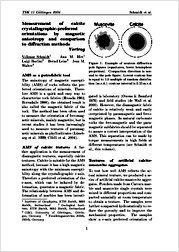Measurement of calcite crystallographic-preferred orientations by magnetic anisotropy and comparison to diffraction methods
2006Universitätsverlag Göttingen
Sammelband- / Konferenzbeitrag
Verlagsversion
Deutsch
Schmidt, Volkmar; Hirt, Ann M.; Burlini, Luigi; Leiss, Bernd; Walter, Jens M., 2006: Measurement of calcite crystallographic-preferred orientations by magnetic anisotropy and comparison to diffraction methods. In: Philipp, S.; Leiss, B; Vollbrecht, A.; Tanner, D.; Gudmundsson, A. (eds.): 11. Symposium "Tektonik, Struktur- und Kristallingeologie"; 2006, Univ.-Verl. Göttingen, p. 194 - 195., , DOI: 10.23689/fidgeo-1895.
 |
Dokument öffnen: |
The anisotropy of magnetic susceptibility
(AMS) of rocks reflects the preferred
orientations of minerals. Therefore
AMS is a quick and easy way to
characterize rock fabrics (Hrouda 1982,Borradaile 1988); the obtained result is also called the magnetic fabric of the
rock. The method has been often used
to measure the orientation of ferromagnetic
minerals, mainly magnetite, but in
recent studies it has been increasingly
used to measure textures of paramagnetic
minerals as phyllosilicates (Lüneburg
et al. 1999, Cifelli et al. 2004).
A further application is the measurement of
diamagnetic textures, especially calcite
textures. Calcite is suitable for the AMS
method, because it has a high magnetic
anisotropy with the minimum susceptibility
along the crystallographic c-axis.
Therefore a preferred orientation of the
c-axes, which can be induced by deformation,
generates a magnetic fabric...
Statistik:
ZugriffsstatistikSchlagworte:
CalzitMagnetische Suszeptibilität
Kristallorientierung
Röntgendiffraktometrie
Neutronendiffraktometrie
Vergleichsmessung
Gefügekunde der Gesteine
Methodik {Strukturgeologie}
Erdmagnetische Verfahren {Geophysik}
Gesteinsmagnetismus {Geophysik}
Röntgenanalyse {Mineralogie: Kristallographie}

